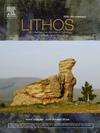A near-surface fine-velocity structure in the western Hoh Xil Basin revealed by first-arrival travel-time tomography from a deep seismic reflection profile
IF 2.9
2区 地球科学
Q2 GEOCHEMISTRY & GEOPHYSICS
引用次数: 0
Abstract
The Hoh Xil Basin (HXB) is a key site for continental sedimentation from the Late Cretaceous to the Neogene on the northern-central Tibetan Plateau and provides a record of regional tectonic activity before and after the onset of the India-Asia collision in the early Paleogene. On the basis of a deep seismic reflection profile spanning the western HXB, we used the first-arrival travel-time tomography method to study the shallow upper crustal structure beneath the area in detail. Our images revealed a high-resolution 2D P-wave velocity structure at an approximate depth of 4 km. The P-wave velocity structure constrains the shallow upper crustal tectonics of the area and allows some speculation regarding its geodynamics. P-wave velocities exceeding 4.0 km/s were observed in the widely distributed Triassic flysch deposits within the western HXB. Lateral velocity perturbations are based on P-wave velocity structure calculations and can increase the lateral resolution of the profile and accurately delineate stratigraphic boundaries across different geological ages in the shallow upper crust. During the Late Cretaceous to Early Eocene (81–50 Ma), the amount of crustal shortening within the Tanggula thrust was estimated to have been greater than 50 % throughout the HXB, reflected by the complex P-wave velocity structure of the Kangtuo Formation. During the middle Eocene to Oligocene (45–28 Ma), the Hoh Xil thrust fault and Fenghuoshan thrust fault controlled the deposition of the Suonahu Formation in the west and the Yaxicuo Formation in the east, respectively, as well as the subsequent tectonic deformation. Our results indicate that the tectonic deformation and shortening of the upper crust during this period led to crustal thickening and elevation uplift. The Neogene Wudaoliang Formation in the eastern HXB and the Quaternary sedimentary layers in the western HXB show no signs of tectonic deformation. These results indicate that the uplift of the HXB after the Neogene was unlikely to be related to upper crustal tectonic deformation.
深地震反射剖面初到行时层析成像揭示了科西盆地西部近地表细速度结构
可可西盆地(HXB)是青藏高原中北部晚白垩世至新近纪陆相沉积的重要场所,是早古近纪印度-亚洲碰撞发生前后区域构造活动的记录。在HXB西部深地震反射剖面的基础上,采用初到行时层析成像方法对该区域下浅层上地壳结构进行了详细研究。我们的图像显示了一个高分辨率的二维纵波速度结构,大约在4公里的深度。纵波速度结构限制了该地区的浅层上地壳构造,并允许对其地球动力学进行一些推测。在HXB西部广泛分布的三叠系复理石沉积中观测到的纵波速度超过4.0 km/s。横向速度摄动基于纵波速度结构计算,可以提高剖面的横向分辨率,准确圈定上地壳浅层不同地质时代的地层边界。在晚白垩世至早始新世(81 ~ 50 Ma)期间,唐古拉逆冲构造的地壳缩短量在整个HXB都大于50%,这反映在康托组复杂的纵波速度结构上。始新世中期至渐新世(45 ~ 28 Ma),西侧的嗬西逆冲断层和东侧的峰火山逆冲断层分别控制了索那湖组和亚西措组的沉积及其后的构造变形。结果表明,这一时期上地壳的构造变形和缩短导致了地壳增厚和隆升。东段新近系五道梁组和西段第四纪沉积层未见构造变形迹象。这些结果表明,新近纪以后HXB的隆升不太可能与上地壳构造变形有关。
本文章由计算机程序翻译,如有差异,请以英文原文为准。
求助全文
约1分钟内获得全文
求助全文
来源期刊

Lithos
地学-地球化学与地球物理
CiteScore
6.80
自引率
11.40%
发文量
286
审稿时长
3.5 months
期刊介绍:
Lithos publishes original research papers on the petrology, geochemistry and petrogenesis of igneous and metamorphic rocks. Papers on mineralogy/mineral physics related to petrology and petrogenetic problems are also welcomed.
 求助内容:
求助内容: 应助结果提醒方式:
应助结果提醒方式:


